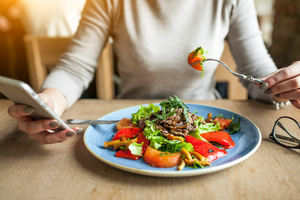In this article:
- Vegetables are low in calories and high in nutrients. They can help with weight loss and health management.
- Eating vegetables first at your meals may help manage weight and improve health outcomes.
- Having a salad, vegetable soup, or other vegetables before your meal can be a long-term strategy to help you reach your goals.
- Lark can support your goals and help you stay motivated as you make progress towards your health and weight loss goals with or without GLP-1s as you log food, get tips for eating healthier, and make small changes that can turn into healthy habits.
Eating to manage weight and improve health can get complicated, but sometimes, there are simple tricks to help. For example, what about eating vegetables first at your meals? Research shows that this straightforward strategy can be effective. Here’s why it works, and how you can use it.
Weight Loss and Health Benefits of Eating Vegetables First
When you eat your vegetables first, you’re likely to eat more vegetables overall than when you eat other types of foods first. This can have lots of benefits for weight management and health.
Better Weight Control
Eating more vegetables helps with weight loss and prevention of weight gain. Vegetables are relatively low in calories compared to other types of foods. A 1-cup serving of tomatoes, for example, has 35 calories, while a cup of cottage cheese or sweet potato has about 200 calories. Research supports this, as the USDA finds that people eating more vegetables have lower calorie intakes.
These results can be good news for people who want a sustainable way to eat better. Compared to a complicated set of instructions about what and how much to eat, it’s simple to “eat vegetables first and carbohydrates last,” as the authors in the Nutrients article point out.
Improved Nutrient Consumption
Vegetables are high in many essential nutrients. What We Eat in America, an ongoing national survey of food consumption has found that people who eat more vegetables tend to have higher intakes of fiber and potassium. These nutrients are low in most people’s diets, but increasing consumption may lower the risk for heart disease, diabetes, and high blood pressure.
The USDA also reports that people eating more vegetables are more likely to stay within the recommended limits for saturated fat, added sugars, and sodium. This could be because filling up on vegetables leaves less room for things like starchy sides, fatty proteins, or high-calorie desserts at the meal. It’s also possible that eating vegetables, and the fiber that they contain, keep blood sugar more stable and supports fullness for longer after a meal.
Lower Blood Sugar
In a study published in the journal Nutrients, researchers gave participants the same meal. They asked some participants to eat their vegetables before their rice, a carb, and others to eat their rice before their vegetables. Researchers also tested the effects of eating slowly or quickly.
It turned out that eating vegetables before carbs led to benefits like lower blood sugar and lower insulin after the meal. This was true whether participants ate slowly or quickly, which suggests that there’s a benefit simply to changing the order of your meal.
There’s even evidence from longer-term studies that eating vegetables first can lower blood sugar. The study in Nutrients refers to research among participants with type 2 diabetes. In that study, patients who reported eating vegetables first at the meal had better glycemic control and fewer complications from diabetes.
How to Maximize Benefits from Vegetables
The first step to maximizing the benefits from vegetables is to eat them! Try to include them in most meals and snacks. Start to make an effort to eat them first. You can also apply this at snack time by eating vegetables first or, if it’s just a small snack, by choosing vegetables when you can.
Once you’re regularly including vegetablest, consider increasing the amount you have. A good goal is to fill half of your plate or bowl with vegetables at most meals.
You can also try to include a half-cup or more vegetables in most snacks. Examples include raw vegetables with cottage cheese, hummus, salsa, or guacamole, skewers with grilled vegetables and shrimp or chicken, and cucumber slices with low-fat cream cheese.
Here are some examples of ways to eat vegetables first.
- Fill half of your plate full with vegetables or salad before anything else
- Serve a green or other vegetable salad as the first course, before serving other items
- Start your meal with a broth-based, chunky, vegetable soup, like bean and vegetable, minestrone, or cabbage soup
It’s a little trickier if your vegetables are mixed in with other foods at the meal. Here are some tips.
- Add an extra salad, vegetable, or vegetable soup before the meal
- If the vegetables are mixed with lean protein, like scrambled egg whites with spinach or salmon stir fry with vegetables, you can eat that before a starch like rice or potatoes
- Try increasing the amount of vegetables compared to other types of foods in the meal
Any steps you take towards getting more vegetables and eating them first may help you reach your goals!
How Lark Can Help
Weight management and health are about healthy eating, staying active, and making other positive choices on a daily basis. Your Lark coach is available 24/7 for encouragement and expert coaching. Lark can help you make healthy choices and establish habits that fit into your lifestyle so you can lose weight and keep it off with or without GLP-1 medications.
Click here to see if you may be eligible to join Lark today!











.webp)








